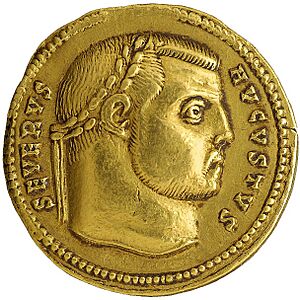Severus II facts for kids
Quick facts for kids Severus II |
|||||
|---|---|---|---|---|---|

Aureus from 306 or 307 depicting Severus
|
|||||
| Roman emperor (in the West) | |||||
| Augustus | 25 July 306 – April 307 (with Galerius in the East) |
||||
| Predecessor | Constantius I | ||||
| Successor | Maxentius (de facto) Licinius (de jure) |
||||
| Co-ruler | Constantine I | ||||
| Caesar | 1 May 305 – 25 July 306 (under Constantius I) |
||||
| Born | Flavius Severus Illyria |
||||
| Died | September 307 Tres Tabernae |
||||
| Issue | Flavius Severianus | ||||
|
|||||
Flavius Valerius Severus (died September 307), also called Severus II, was a Roman emperor from 306 to 307, and a member of the Tetrarchy. He shared control of the western half of the empire with Constantine I, but spent most of his short reign in a civil war against the usurper Maxentius, who later killed him and took over Italy.
Background and early career
Severus was of humble birth, born in Northern Illyria around the middle of the third century. A friend of emperor Galerius, he rose to become a senior officer in the Roman army, being nominated as caesar of the Western Roman Empire. According to Lactantius, Diocletian objected to Galerius's suggestion, saying in response, "What! That dancer, that habitual drunkard who turns night into day and day into night?" Galerius persisted, saying that Severus has served faithfully as paymaster and purveyor of the army. Diocletian acquiesced and Severus succeeded to the post of caesar on 1 May 305, thus becoming the junior colleague of Constantius I, augustus of the western half of empire.
Augustus, 306–307
When Constantius died in Britain in July 306, his son Constantine I was immediately acclaimed emperor by his soldiers. At the same time, Severus was promoted to augustus by Galerius. Lactantius reports that Galerius had done this to promote the older man to the higher office, while accepting the imperial symbols of Constantine and accepting him as a member of the Tetrarchy, albeit with the rank of caesar. Despite his lower title, Constantine controlled most of the Western empire (Britain, Gaul, and Hispania), leaving Severus with the control of Italy and Western Africa.
When Maxentius, the son of the retired emperor Maximian, revolted at Rome in October, Galerius sent Severus to suppress the rebellion. Severus moved towards Rome from his capital, Mediolanum, at the head of an army previously commanded by Maximian. Fearing the arrival of Severus, Maxentius offered Maximian the co-rule of the empire. Maximian accepted, and when Severus arrived under the walls of Rome and besieged it, his men deserted to Maxentius. Severus fled to Ravenna, an impregnable position. Maximian offered to spare his life and treat him humanely if he surrendered peaceably, which he did around April 307. Despite Maximian's assurance, Severus was nonetheless displayed as a captive and later imprisoned at Tres Tabernae, near the current Cisterna di Latina. One belief is that when Galerius himself invaded Italy to suppress Maxentius and Maximian, the former ordered Severus's death. His death probably took place in September or October, as documents with his name were still issued in September, while news of his death already arrived in Egypt by December.
The position of Western augustus remained officially vacant until the Conference of Carnuntum of November 308, in which Licinius was appointed as new emperor (although his western domains only consisted of the Balkan Peninsula). Severus was survived by his son Flavius Severianus, but he was later executed by Licinius for treason.
See also
 In Spanish: Severo II para niños
In Spanish: Severo II para niños

